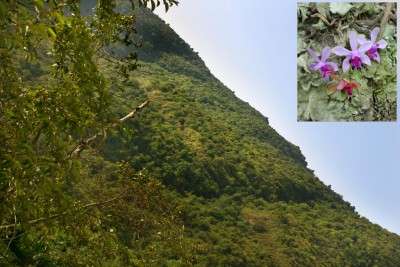Evolution of Himalayan flowers sheds light on climate change

Flower colour in some parts of the world, including the Himalayas, has evolved to attract bees as pollinators, research has shown for the first time.
In a study published in the Journal of Ecology, biologists from Monash University and RMIT University have investigated the evolution of flower colours due to the bee's colour vision. They researched in the understudied Nepalese steep mountainous terrain, and other subtropical environments. The study also has implications for understanding the effects of climate change on plant pollination.
Associate Professor Adrian Dyer of Monash and RMIT said previous studies had shown that flower colour evolved to attract bees as pollinators in temperate environments, but the story for either subtropical or steep mountainous environments had been unknown.
"Mountainous environments provide an ideal natural experiment to understand the potential effects of changing climatic conditions on plant-pollinator interactions, since many pollinators show preferences for localised conditions, and major pollinators like honeybees do not tend to forage at high altitudes," Associate Professor Dyer said.
Dr Mani Shrestha from Monash University and his colleague Prakash Bhattrai from the Tribhuvan University, Kathmandu, collected spectral data from more than 100 flowering plants in Nepal over a range of altitudes, from 900 metres to over 4000 metres.
Using computer models to examine flower colours as bees would see them, the team addressed how pollinator vision had shaped flower evolution. Then, with Associate Professor Martin Burd, of the School of Biological Sciences, they did phylogenetic analyses to identify how altitude zones affected results.
Dr Shrestha said flowers from both subtropical (900-2000m) and alpine (3000-4100m) regions showed evidence of having evolved colour spectral signatures to enhance discrimination by bee pollinators.
"The finding was a surprise as flies are thought to be the main pollinator in many mountain regions, but it appears that in the Himalayas several bee species are also active at high altitude, and these insects have been such effective pollinators that they have led to the evolution of distinctive bee-friendly colours," Dr Shrestha said.
The research could shed light on how flower colours may continue to evolve in particular environments, depending upon the availability of the most effective pollinators.
While 'bee colours' were prevalent at all elevations, flower colours in high altitude zones were more diverse and had more often undergone larger steps of evolutionary change than those at lower elevation, Associate Professor Burd said.
"Studying these patterns helps scientists understand how plant communities are assembled, and are potentially able to deal with changing conditions."
Journal information: Journal of Ecology
Provided by Monash University



















